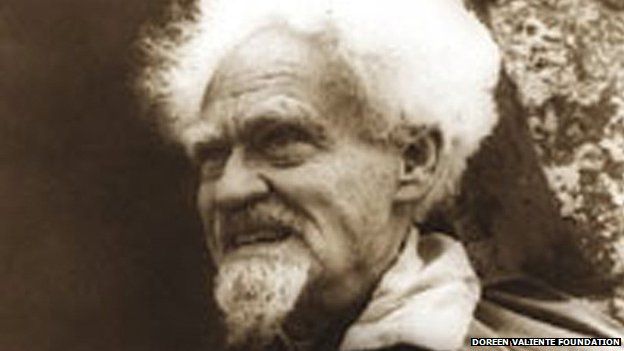Gerald Gardner: Legacy of the 'father of witchcraft'
- Published

Gerald Gardner worked to ensure the survival of Wiccan culture, gaining worldwide attention
A blue plaque is being unveiled in Dorset at the former home of Gerald Brosseau Gardner. He is regarded by many as the "father of modern witchcraft", but who was he and what was his legacy?
Southridge, a comfortable 1920s house in Highcliffe, was bought by Gardner and his wife, Dorothea, in 1938 when they moved from London.
Until then Gardner's life had been unremarkable for someone of his wealthy background in the colonial era.
Born in 1884, he had been sent to the warmer climes of Madeira as a child in a bid to alleviate his asthma. Consequently he received little education and later claimed he had taught himself to read.
As a young man, he spent time working in Ceylon, Borneo and Malaya before returning to London in 1936.
After arriving in Highcliffe, shortly before the outbreak of war, he became acquainted with a group claiming to be witches and was initiated into the New Forest Coven at nearby Mill House.
It proved to be a turning point for Gardner who, from that time, devoted himself to promoting his new-found religion.
Biographer and Wiccan initiate Philip Heselton said: "He wasn't a religious pioneer. What he did was to publicise it and write about it and he gradually became known through that and people made contact.
"He initiated quite a lot of people into the Wiccan culture. He felt it was important that it survived."
Gardner said he was initiated into the New Forest Coven in Mill House, not far from his home in Highcliffe
Gerald Gardner's book of shadows - containing his rituals - was given to High Priestess Doreen Valiente
After the war Gardner returned with his wife to London where he wrote a number of books, the best known being Witchcraft Today. Published in 1954, it offered readers an insight into the history and practices of the witch-cult and offered the press a feeding frenzy.
Mr Heselton added: "There were headlines about lurid rites and evil black magic but, in actual fact, quite a lot of people saw through it. He got lots of letters as a result of that, which helped him enormously."
Unreliable witch?
Gardner's theories were drawn from numerous sources, including Freemasonry, magical orders such as the Golden Dawn and fellow occultists, including Aleister Crowley.
He also formulated the Wicca calendar of eight festivals, bringing together existing festivals from different traditions.
By the time of his death in 1964, Gardnerian Wicca, as it became known, had spread to the United States and beyond. Estimates of the number of Wiccans worldwide range from 100,000 to 800,000.
But while Gardner's legacy is virtually undisputed, details of his life continue to be scrutinised.
Historian Prof Ronald Hutton said: "He was a man of extraordinary charm and mischief, generous and with warmth of heart, but something of a trickster.
"Most of those who knew him found him fun but slightly unreliable when it came to witchcraft."
He said Gardner often stretched the truth and encouraged coven members to claim they were from an ancient lineage of witches.
"I think he encouraged people to tell the press things about themselves that weren't true," he said.
The plaque is being unveiled on Friday, the 130th anniversary of Gardner's birth in 1884.
- Published13 June 2014
- Published13 June 2013
- Published10 June 2013
- Published20 August 2012
- Published27 June 2011